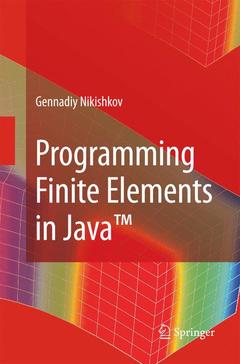Description
Programming Finite Elements in Java™, 2010
Author: Nikishkov Gennadiy P.
Language: English
Subjects for Programming Finite Elements in Java™:
Publication date: 11-2014
402 p. · 15.5x23.5 cm · Paperback
Approximative price 94.94 €
In Print (Delivery period: 15 days).
Add to cartPublication date: 02-2010
402 p. · 15.5x23.5 cm · Hardback
Description
/li>Contents
/li>Biography
/li>Comment
/li>
Programming Finite Elements in Java? teaches the reader how to programme the algorithms of the finite element method (FEM) in Java?. The compact, simple code helps the student to read the algorithms, to understand them and thus to be able to refine them. All of the main aspects of finite element techniques are considered: finite element solution; generation of finite element meshes; and visualization of finite element models and results with Java 3D?.
The step-by-step presentation includes algorithm programming and code explanation at each point. Problems and exercises are provided for each chapter, with Java? source code and problem data sets available from http://extras.springer.com/2010/978-1-84882-971-8.
Gennadiy Nikishkov got his PhD and DSci degrees from the Moscow Engineering Physics Institute (Technical University) in computational mechanics. He held a professorship at the Moscow Engineering Physics Institute. He also had visiting positions at Georgia Institute of Technology (USA), Karlsruhe Research Center (Germany), RIKEN Institute of Physical, Chemical Research (Japan) and GKSS Research Center (Germany) and University of California at Los Angeles (USA). Currently Gennadiy Nikishkov is a Professor at the University of Aizu (Japan). His activities and research interests include computational mechanics, computational fracture mechanics, computational nanomechanics, development of finite element and boundary element codes, scientific visualization and computer graphics. For many years he taught courses on computational modeling using the finite element method.
Use of Java™ as a programming language provides students with easy-to-understand compact algorithm development
Provision of explanation for each coding step ensures that every stage of learning is firmly cemented before proceeding to the next
Source code and problem data allow students to practise what they have learnt and saves tutors time
Includes supplementary material: sn.pub/extras




